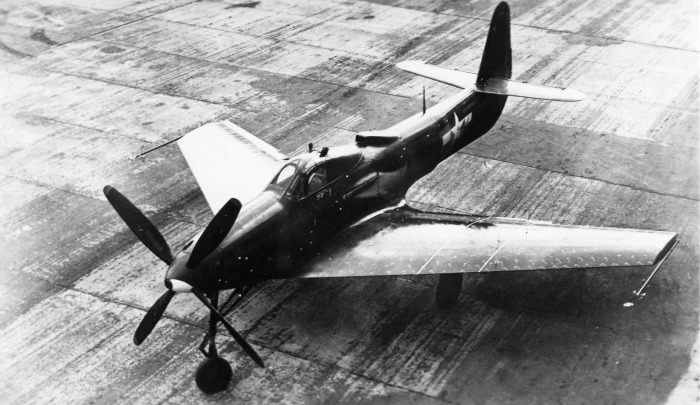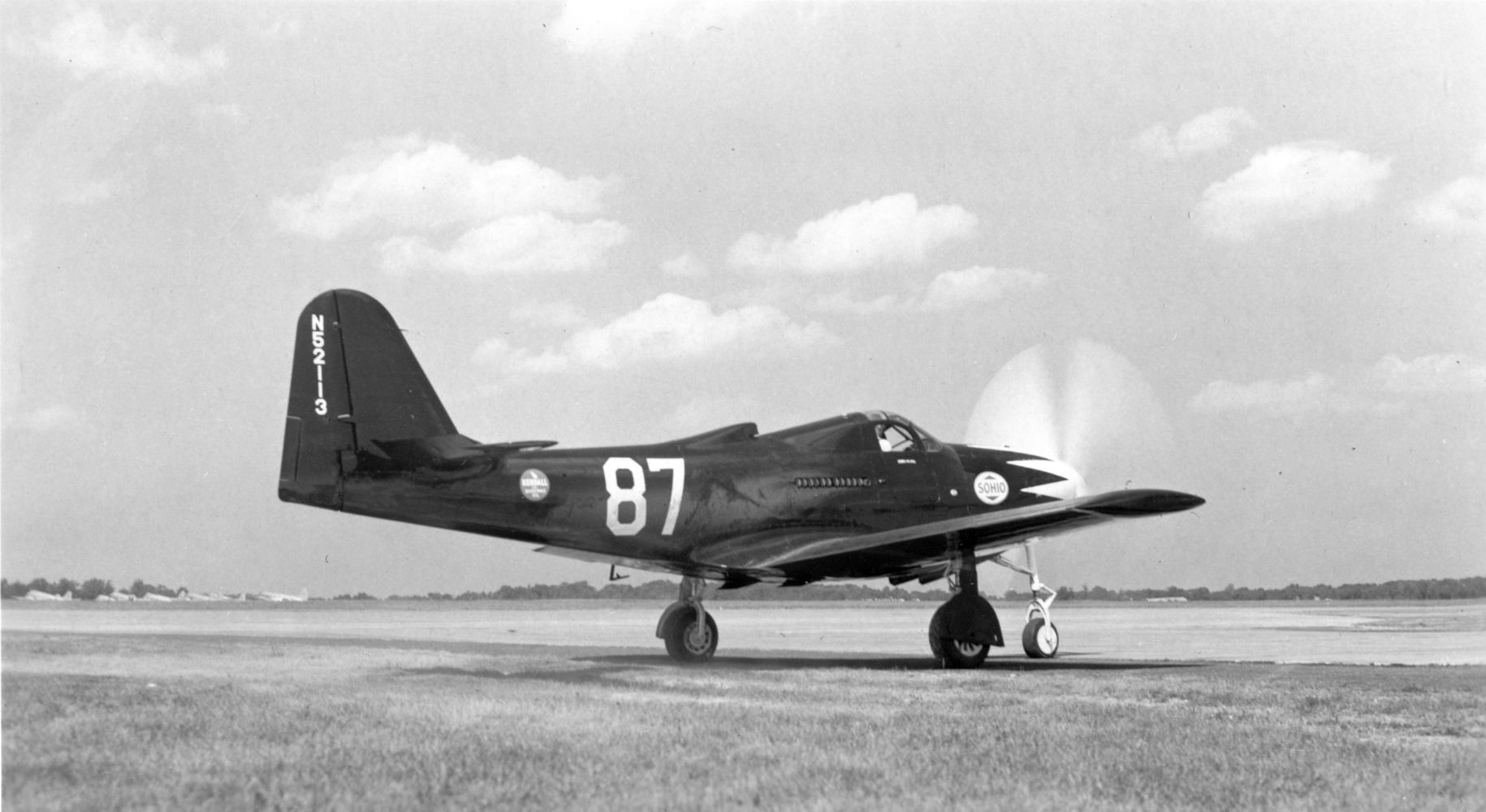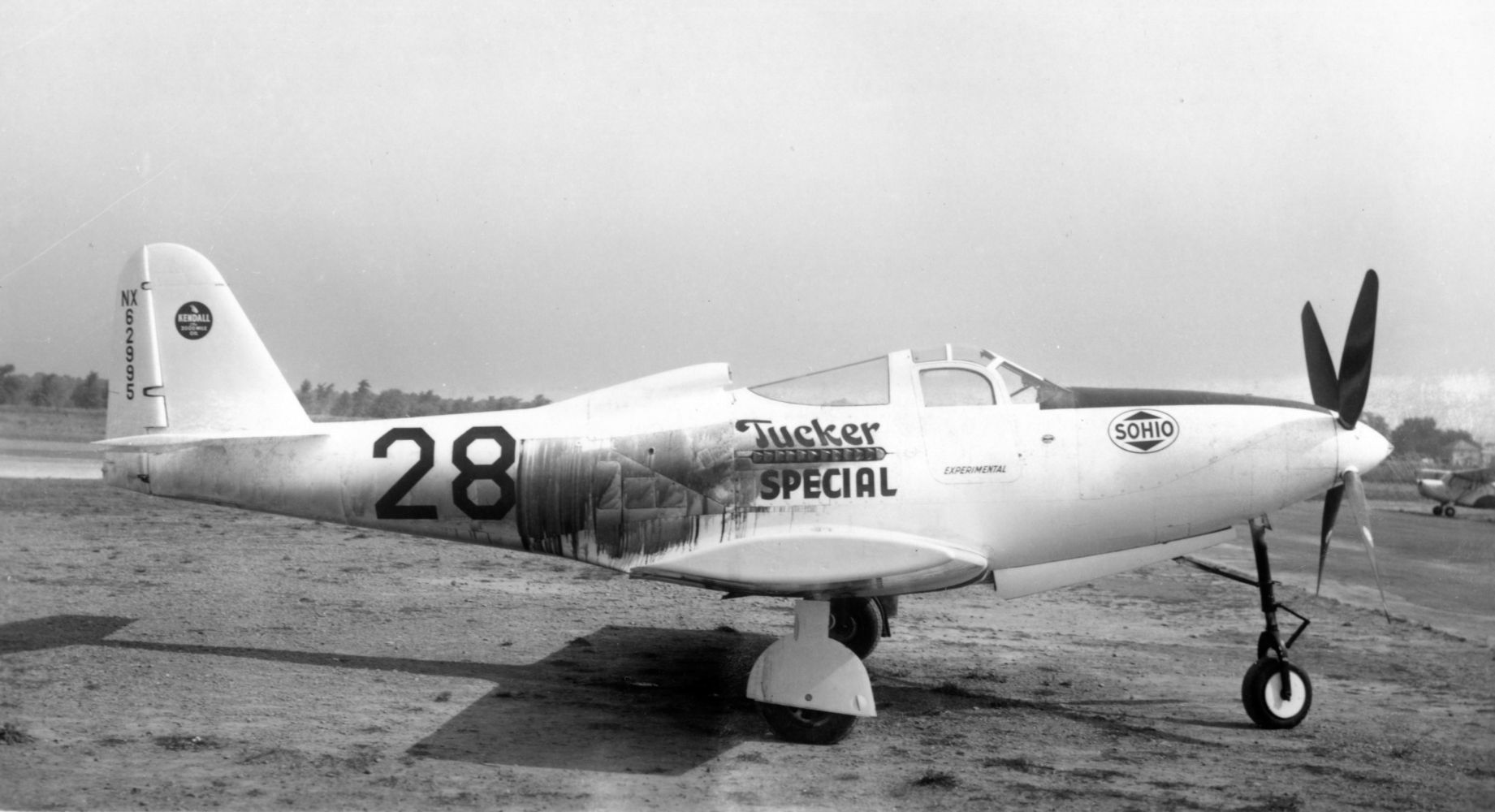On this day in aviation history, December 7, 1942, the Bell P-63 Kingcobra made its first flight. Often overlooked in comparison to other U.S. fighters of WWII, the P-63 Kingcobra would still play a role in the Allied war effort in supplying America’s overseas allies and being used for one of the most unusual operations of WWII. In order to trace the roots of the P-63, one must examine its direct predecessor, the Bell P-39 Airacobra. The Airacobra had been intended to be a high-altitude interceptor, complete with an M4 37mm autocannon, but with the removal of the prototype’s turbo-supercharger in favor of a single-stage, single speed supercharger, the P-39 now exhibited poor high-altitude performance, and this saw the aircraft used for low to medium-altitude operations, and Bell proposed a new aircraft to improve performance.

Originally, that aircraft was to be the XP-39E (later redesignated the XP-76), whose fuselage and wingspan were lengthened and was to be powered by the Continental XI-1430 inverted V12 engine. However, the XP-76 had to fly with a new variant of the P-39’s Allison V-1710 due to the unavailability of the Continental engine, and eventually the XP-76 itself was cancelled. However, the US Army Air Force was still interested in an improved version of the P-39, and so a new design was drafted. It featured a laminar flow airfoil, the Allison V-1710 was fitted with a second supercharger, a four-bladed propeller was installed, and the nose cowlings to access the airplane’s 37mm gun and two Browing M2 .50 caliber machine guns were enlarged for ease of access for armorers.
The resulting design, referred to by Bell as the Model 33, was called the P-63 Kingcobra, and two prototypes (XP-63 41-19511 and XP-63 41-19512) were prepared for flight testing with the Allison V-1710-47. A third prototype, XP-63A 42-78015, would originally be ordered to be equipped with a Packard V-1650 Merlin, but this was later delivered with an Allison due to the demand for Packard Merlins in the production of P-51 Mustangs. Both of the first two prototypes, however, would be flight tested without the wing mounted .50 caliber guns intended for the production models, similar to the arrangement on the P-39Q variant.

The first prototype, serial number 41-19511, would fly for the first time on December 7, 1942, at Bell’s plant in Buffalo, NY. This coincided with the first anniversary of the attack on Pearl Harbor, and for all those who were present, the significance was not lost on them. Already, the design proved itself to be a superior one to the P-39. However, the P-63 itself would, like the nation that created it, have some challenging days ahead. On January 28, 1943, Bell test pilot Jack Woolams was coming back from a test flight in 41-19511 when he realized that the landing gear failed to extend. After all efforts to bring the gear down failed, he circled the airfield to burn off his fuel to conduct a belly landing. By the time he had burned off enough fuel to make the landing safe, though, it was dark in Buffalo, and Woolams mistook the side lights on the runway for the end lights and as a result, the XP-63 skidded into a grove of trees. Though Woolams walked away unscathed, the same could not be said of the first P-63, which was beyond repair and subsequently shipped to Wright Field, Dayton, OH for ground firing tests.

The second XP-63, 41-19512, did not fare any better. After making its first flight on February 5, 1943, it was lost just three months later on May 4 when a piston rod shot through the aircraft and the cockpit filled with smoke. Test pilot Gustav E. “Gus” Lundquist was forced to bail out, and 41-19512 was destroyed in the subsequent crash. After the remaining prototypes and pre-production aircraft were further flight tested, the USAAF determined that the overall performance of the P-63, while superior to the P-39, was still inferior to contemporaries such as the P-51 Mustang, and thus these other fighters were prioritized for frontline duty overseas. P-63As would be flown by several squadrons in the continental United States. P-39 Airacobras had by this point already been exported to the Soviet Union to fight on the Eastern Front, where they were highly favored among Soviet pilots, and upon learning of the P-63 Kingcobra, the Soviets expressed interest in purchasing examples for their own use. They even tested an example at the Central Aerohydrodynamic Institute (Russian acronym TsAGI) in Moscow, where this data was relayed to Bell Aircraft to create improvements to subsequent production models.
Much like the P-39 Airacobra, the majority of the P-63 Kingcobras would be exported to the Soviet Union. They would be ferried from the factory in Buffalo across the United States and Canada to Alaska, where they would be received by Russian pilots who would fly them across the Bering Strait into Siberia. Reportedly, there had been an agreement between the Americans and the Soviets that the Kingcobras were to be reserved only for squadrons in the Far East, held on standby in case the Soviets should break their neutrality with Japan, but Western and Russians sources have conflicting information on the veracity of this account. What is beyond dispute, however, is that when the Soviet Union declared war on Japan on August 9, the same day that the Japanese city of Nagasaki became the second and last city attacked by nuclear weapons, Soviet Kingcobras saw combat flying escort missions, close air support, and ground attack missions against Japanese forces in Manchukuo (Manchuria) and Korea. On August 15, 1945, the same day Emperor Hirohito announced the surrender of Japan, Lt. I. F. Miroshnichenko of the 17th Fighter Aviation Regiment, 190th Fighter Aviation Division scored the Kingcobra’s first aerial victory when he shot down a Nakajima Ki-43 Hayabusa off the coast of northern Korea. After the war, the thousands of P-63 Kingcobras remained in Soviet service, and were later referred to by NATO with the codename ‘Fred’, serving as transitionary fighters and instructional airframes as the Soviets shifted towards advanced jet fighters such as the Mikoyan-Gurevich MiG-15.
Another foreign operator of the Kingcobra was the French Air Force, which received 114 P-63s from the USA in 1945. While these arrived too late to be flown in WWII, the French would send 48 to Indochina to serve in the war France was fighting to maintain its prewar hold over modern-day Vietnam, Laos, and Cambodia. Due to the fact that the French had to get permission from the Americans to send the Kingcobras to Indochina, they did not arrive until 1949, and by 1951, due to the lack of spare parts and ammunition for the 37mm cannons, the P-63s in Indochina were replaced by Grumman F8F Bearcats.

Back in the United States, several Kingcobras were requisitioned for a most unusual type of combat training. Like fighter pilots, aerial gunners assigned to bombers needed to practice their gunnery. The most common type of training was to have a plane tow a target for the gunners to shoot at. But due to safety concerns, the tow targets were not very maneuverable, and so the USAAF sought a more dynamic alternative to mimic an enemy fighter making runs on the bomber. The solution was to make the Kingcobra a manned target. A type of frangible bullet made of a lead/Bakelite combination, designed to shatter on impact, would be fed into the ammunition belts of Browning .30 caliber machine guns, while an unarmed RP-63 (R standing for “Restricted”), painted in high visibility colors and fitted with added sheet metal and sensors to detect hits. The addition of a light added in the propeller hub muzzle for the 37mm gun equipped in stock P-63s to register to the trainees a hit gave the project the nickname “Pinball”.

Besides their work in the “Pinball” program, Kingcobras were also used for flight experimentation. Two examples were sent to the UK to be used for laminar flow flight tests with the Royal Aircraft Establishment (RAE) at Farnborough, England. Similarly, the National Advisory Committee for Aeronautics (NACA; the predecessor of NASA) would conduct flight testing with USAAF P-63s during the war, and improvements were proposed on several unique variants of the P-63, such as the P-63D, which notably featured a sliding bubble canopy as opposed to the cab door configuration on P-39s and stock P-63s, or the P-63F, which was fitted with an enlarged vertical stabilizer (one of the two P-63Fs was later flown by the Commemorative Air Force until it was destroyed in a midair collision with the B-17 Texas Raiders in 2022). Two of the most radical configurations was a P-63A modified with a V-tail similar to that seen on the Beechcraft Bonanza, and the L-39, a swept-wing development of the P-63 built for NACA and the US Navy in order to test swept wing flight characteristics for the next generation of American fighter jets.
After being declared surplus, many Kingcobras would be modified to become postwar air racers. The prewar races held in places like Cleveland were highly popular before the outbreak of WWII, which forced a temporary halt that lasted until 1945. Now, there were plenty of cheap but fast surplus aircraft, pilots who knew how to fly them, and mechanics and engineers who knew not only how to maintain them, but to modify them to get every ounce of performance they could from the design. The first races they appeared in was the 1946 Thompson Trophy race held in Cleveland and were also entered into the Bendix Trophy cross-country race from Los Angeles to Cleveland, with a few examples also competing in the later National Championship Air Races in Reno, Nevada, with being modified with clipped wings, souped-up Allisons, and even a tiny bubble top canopy in the case of one racer.
Today, there are several Kingcobras on public display around the world, from Honduras to Russia, but as of 2022, only four examples (three P-63As, one P-63C) remain in airworthy condition, all in the United States. P-63A Miss Betty, a former NACA test aircraft, is flown by the Commemorative Air Force’s Airbase Georgia Wing in Peachtree City, GA. Pretty Polly is flown by the Palm Springs Air Museum in Palm Springs, CA, Fatal Fang is in an airworthy condition with the Yanks Air Museum in Chino, CA, and a P-63C formerly flown by Apollo 8 astronaut Frank Borman is flown by the Legacy Flight Museum in Rexburg, ID.
The Bell P-63 Kingcobra may have been an unsung aircraft of the Second World War, but it was by no means a useless aircraft. From export fighter to manned aerial target, research testbed and air racer, it can be argued that while the Kingcobra never got to fly in frontline US fighter units, the reasoning for that was not due to any fault of the aircraft itself but because it had too much competition from other designs such as the P-51 Mustang or the P-47 Thunderbolt. In the end, however, the aircraft played its part and remains an iconic aircraft of the Second World War.
Today in Aviation History is a series highlighting the achievements, innovations, and milestones that have shaped the skies. All the previous anniversaries are available HERE





































